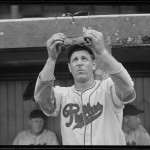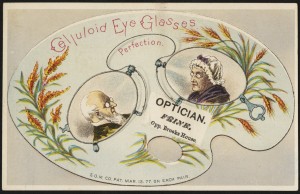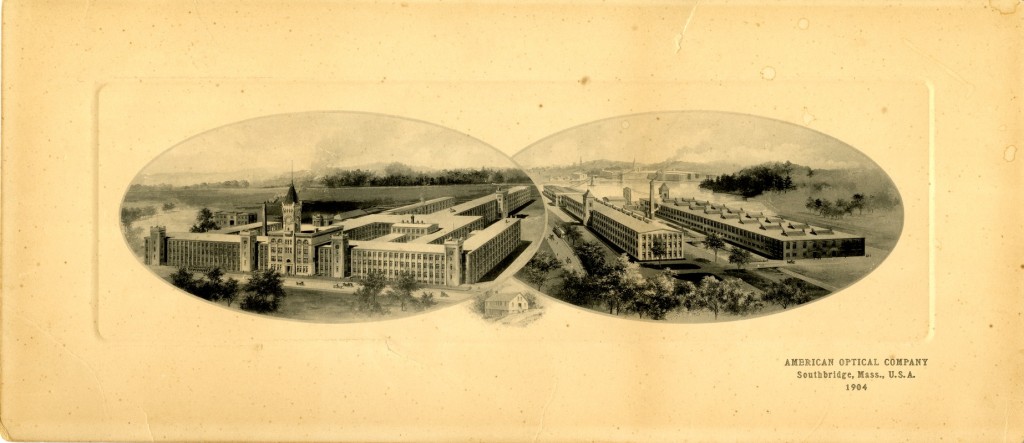 August is National Eye Exam Month, which seemed like a good enough reason to go looking through the Digital Commonwealth for pictures of eyeglasses — and there’s a lot to see.
August is National Eye Exam Month, which seemed like a good enough reason to go looking through the Digital Commonwealth for pictures of eyeglasses — and there’s a lot to see.
The photo on the left shows Philadelphia Phillies player Morrie Arnovich examines his glasses in front of the dugout at Braves Field. It was taken in 1939 by news photographer Leslie Jones and is from the Leslie Jones Collection of the Boston Public Library. There are some other eyeglass photos in the Leslie Jones Collection, including an undated woman with giant eyeglasses (perhaps from a trade show?), a 1932 photograph of Commandant Finlay, Quincy Yacht club, wearing new type of glasses (which look like a cross between eyeglasses and binoculars, a fish wearing glasses and smoking cigar and a dog playing piano wearing glasses.
 The image below is a trade card for an optician selling celluloid eyeglasses from the Boston Public Library’s 19th Century American Trade Cards Collection. The collection includes nearly 4,000 of these color lithographed trade cards, which were a primary form of advertising for both local businesses and national brands, and its a great resource for anyone interested in graphic design, advertising or everyday life in the period between 1870 and 1900. In this case, it provides a very detailed picture of what those eyeglasses looked like. The front of these cards was generally a picture with just a few words describing a product or service, but the back of the cards, also scanned, provided names, addresses, and more information, making these a great resource for local history and genealogy.
The image below is a trade card for an optician selling celluloid eyeglasses from the Boston Public Library’s 19th Century American Trade Cards Collection. The collection includes nearly 4,000 of these color lithographed trade cards, which were a primary form of advertising for both local businesses and national brands, and its a great resource for anyone interested in graphic design, advertising or everyday life in the period between 1870 and 1900. In this case, it provides a very detailed picture of what those eyeglasses looked like. The front of these cards was generally a picture with just a few words describing a product or service, but the back of the cards, also scanned, provided names, addresses, and more information, making these a great resource for local history and genealogy.
But the most interesting eyeglass-related image in the Digital Commonwealth might be the one below — a 1904 collage of two views of the American Optical Company’s Main Plant in Southbridge, displayed in the shape of a pair of eyeglasses, with a small inset in the middle showing the company’s original building.
American Optical roots began when William Beecher opened a shop above his jewelry store to manufacture spectacles, introducing the first steel-framed spectacles made in America. These became very popular and competitors opened nearby, and soon Southbridge became a center of the American spectacle-making industry.
When Beecher retired in 1862, his former apprentice Robert Cole took over the business. Cole hired 18 year old apprentice George Wells, who had a genius for mechanics and innovation. Wells left Cole’s business and bought an interest in a competing firm, and in 1869, Cole and Wells merged the two businesses forming the American Optical Company.
Under the leadership of Wells, the business grew rapidly, buying and converting a textile mill into an optical manufacturing plant, and eventually the company’s Southbridge plants covered 17.5 acres of floor space in 36 different buildings. But foreign competition eventually took its toll: American Optical relocated its manufacturing to Mexico and its headquarters to San Diego in the 1990s. Most of the manufacturing buildings were demolished, but the façade and clock tower were retained and incorporated into the Southbridge Hotel and Conference Center.

